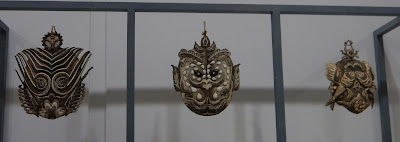Some time ago, we looked at minority groups in southern China, and discussed the reasons for so many different cultures in a relatively small area.
Today, I will take a brief look at some minority groups in northern China. Unfortunately, I haven't been to the areas where they hang out, but there's always next year.
The first observation we can make about these groups is that there are a lot fewer of them than in the south. I think the primary reason for this is that the type of inhospitable land in the north lends itself to a nomadic living scheme. Nomads have to travel long distances, hence cultural cross-pollination will occur over large distances, and you won't see the kind of cultural differentiation that you do in the south, where the inhospitable land is individual mountains.
A lot of the northern artifacts are not that different from other northern hemisphere nomadic peoples. Some of them were even reindeer herders (photos below taken at Nanning Museum of Nationalities in Nanning).
Described as Hezhe 'Theogony', these fish-skin masks are probably representations of deities.
Today, I will take a brief look at some minority groups in northern China. Unfortunately, I haven't been to the areas where they hang out, but there's always next year.
The first observation we can make about these groups is that there are a lot fewer of them than in the south. I think the primary reason for this is that the type of inhospitable land in the north lends itself to a nomadic living scheme. Nomads have to travel long distances, hence cultural cross-pollination will occur over large distances, and you won't see the kind of cultural differentiation that you do in the south, where the inhospitable land is individual mountains.
A lot of the northern artifacts are not that different from other northern hemisphere nomadic peoples. Some of them were even reindeer herders (photos below taken at Nanning Museum of Nationalities in Nanning).
Oroqen outfits (a northern forest people)
Tobacco pouches
Described as Hezhe 'Theogony', these fish-skin masks are probably representations of deities.
Depictions of Hezhe shamen (pasted fish skin)
Hezhe shaman outfit
Uyghur artifacts.
Tibetan pavilion at the Nationalities' Court.












No comments:
Post a Comment